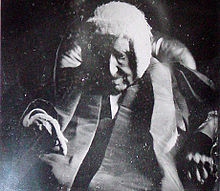|
Martin Routh
Martin Joseph Routh (/raʊθ/, ROWTH; 18 September 1755 – 22 December 1854) was an English classical scholar and President of Magdalen College, Oxford (1791–1854). Birthplace and Oxford careerRouth was born at South Elmham, Suffolk, son of the Rev. Peter Routh, rector there, and his wife, Mary Reynolds. He matriculated at The Queen's College, Oxford, on 31 May 1770 and on 24 July 1771, was elected to a demyship at Magdalen College. He graduated B.A. on 5 February 1774 and was elected on 25 July 1775 to a fellowship of his college. On 23 October 1776 he took an MA, proceeding B.D. in 1786, and D.D. on 6 July 1790. On 21 December 1777, he received deacon's orders from Philip Yonge, Bishop of Norwich; but did not take priest's orders until 1810. He became a college tutor, a librarian in 1781, a Junior Dean of Arts in 1784–5, and in 1785 served as Junior Proctor of the university.[1][2] On 28 April 1791 Routh became the President of Magdalen College, a post he held for the next 63 years until his death in 1854.[3] Literary worksRouth did not excel in modern languages but was an excellent classical scholar. In 1784 was published his edition of the Euthydemus and Gorgias of Plato but as time went on his interests turned towards patristics, which he would devote the rest of his life to studying. He was especially interested in the minor ecclesiastics of the second and third centuries, the ante-Nicene fathers. In 1814 he published two volumes of Sacrae reliquiae; in 1818 the third and fourth volumes appeared; in 1848 appeared the fifth volume. Samuel Parr said on 26 March 1814:
In 1823 appeared Routh's edition of Bishop Burnet's History of My Own Time. This included the notes made by Lord Dartmouth, Lord Hardwicke and Jonathan Swift in their personal copies, along with Routh's own notes. The second edition with corrections appeared in 1833. Samuel Parr wrote to Lord Holland on 16 March 1823: "The new edition of Burnet is honourable to the University...As to the Preface, it is worthy of the learned, wise, upright, candid writer. Routh is a Jacobite, but a Constitutionalist; he is not a Ministerialist; he is really a lover of civil liberty...The perspicuity and ease of the composition was to me delightful".[4] In 1852, aged 97, Routh published the portion of Burnet's History that covered the reign of James II (1685–1689), adding material not included in the previous edition. He presented a copy to the Chancellor of Oxford, the Duke of Wellington. Routh's nephew, who helped him with the book, enquired of him: "Why is it, uncle, that you are always working at Burnet, whom you are always attacking?" Routh replied: "A good question, sir. Because I know the man to be a liar; and am determined to prove him so".[5] Later lifeWhen the American Anglicans visited England in 1783 on to help them set up their own episcopate, Thurlow recommended they consult Routh. Routh advised them against approaching the Lutheran bishops of Denmark and instead recommended they approach the Episcopal Church of Scotland as this church had a high church tradition. On 14 November 1784 Robert Kilgour, Bishop of Aberdeen and Primus of Scotland, Arthur Petrie, Bishop of Ross and Moray, and the coadjutor-bishop of Aberdeen, John Skinner, consecrated Samuel Seabury of Connecticut as bishop. This act was crucial in the survival of the American Episcopal church.[1] In 1810, he was presented with the valuable living of Tilehurst in Berkshire, where, it is recorded, he liked to spend his holidays when not in Oxford. He married Eliza Agnes Blagrave, daughter of John Blagrave of Calcot Park in Tilehurst, a lady some thirty-five years his junior. Last years Routh sympathised with the Tractarians of the High Church Oxford Movement in the 1830s and 1840s. R. W. Church in his history of the Oxford Movement said Routh "had gone below the surface, and was acquainted with the questions debated by those [Anglican] divines, there was nothing startling in what so alarmed his brethren, whether he agreed with it or not; and to him the indiscriminate charge of Popery meant nothing. But Dr. Routh stood alone among his brother Heads in his knowledge of what English theology was".[6] John Henry Newman dedicated his Lectures on the Prophetical Office of the Church (1837) to Routh as one "who has been reserved to report to a forgetful generation what was the theology of their fathers".[7] Shrunken in size and deaf, Routh retained his eyesight, his good memory, and his other intellectual powers to the last, dying at Magdalen College. LegacyMany affectionate stories were told of him, but he is best known today for his response to John Burgon, who asked him what he would say to a young don seeking advice: "You will find it a very good practice always to verify your references, sir!" This is also to be found in the short form, "Always verify your references", with and without the "sir". His last words when he collapsed taking a heavy volume from a high shelf in his library allegedly were: "A worthless volume, sir! A worthless volume!". According to Jan Morris, Routh's last words, spoken to his housekeeper, were "Don't trouble yourself".[8] John Richard Green recalled him "moving like some mysterious dream of the past among the punier creatures of the present".[9] Routh Lane, Tilehurst - adjacent to St Michael's Church - is named after him.,[10] as is Routh Road in Barton, Oxford. Works
Notes
References
Further readingWikiquote has quotations related to Martin Joseph Routh. |
||||||||||||||||||||||||
Portal di Ensiklopedia Dunia
